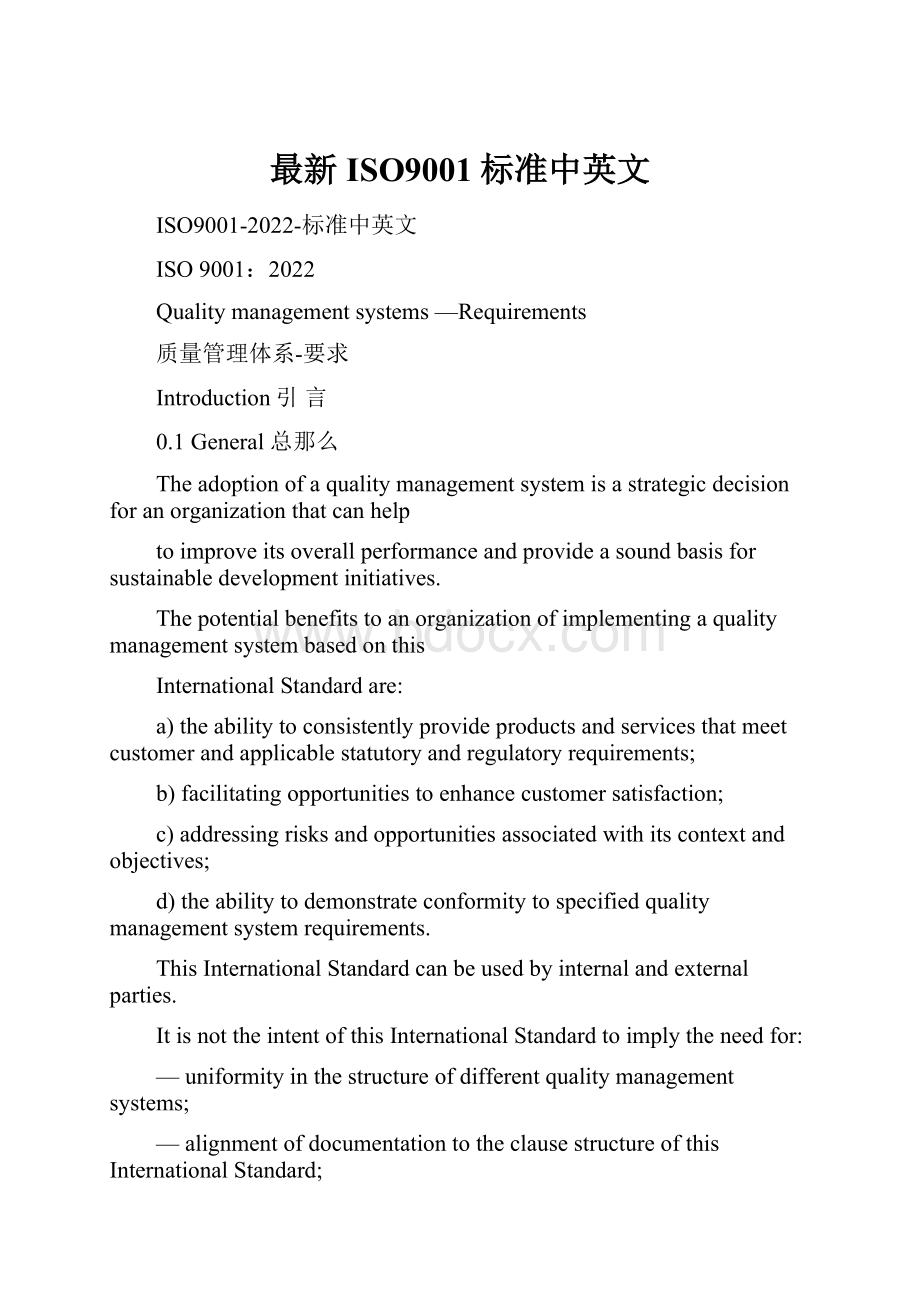最新ISO9001标准中英文.docx
《最新ISO9001标准中英文.docx》由会员分享,可在线阅读,更多相关《最新ISO9001标准中英文.docx(58页珍藏版)》请在冰豆网上搜索。

最新ISO9001标准中英文
ISO9001-2022-标准中英文
ISO9001:
2022
Qualitymanagementsystems—Requirements
质量管理体系-要求
Introduction引言
0.1General总那么
Theadoptionofaqualitymanagementsystemisastrategicdecisionforanorganizationthatcanhelp
toimproveitsoverallperformanceandprovideasoundbasisforsustainabledevelopmentinitiatives.
Thepotentialbenefitstoanorganizationofimplementingaqualitymanagementsystembasedonthis
InternationalStandardare:
a)theabilitytoconsistentlyprovideproductsandservicesthatmeetcustomerandapplicablestatutoryandregulatoryrequirements;
b)facilitatingopportunitiestoenhancecustomersatisfaction;
c)addressingrisksandopportunitiesassociatedwithitscontextandobjectives;
d)theabilitytodemonstrateconformitytospecifiedqualitymanagementsystemrequirements.
ThisInternationalStandardcanbeusedbyinternalandexternalparties.
ItisnottheintentofthisInternationalStandardtoimplytheneedfor:
—uniformityinthestructureofdifferentqualitymanagementsystems;
—alignmentofdocumentationtotheclausestructureofthisInternationalStandard;
—theuseofthespecificterminologyofthisInternationalStandardwithintheorganization.
ThequalitymanagementsystemrequirementsspecifiedinthisInternationalStandardarecomplementarytorequirementsforproductsandservices.
ThisInternationalStandardemploystheprocessapproach,whichincorporatesthePlan-Do-Check-Act(PDCA)cycleandrisk-basedthinking.
Theprocessapproachenablesanorganizationtoplanitsprocessesandtheirinteractions.
ThePDCAcycleenablesanorganizationtoensurethatitsprocessesareadequatelyresourcedandmanaged,andthatopportunitiesforimprovementaredeterminedandactedon.
Risk-basedthinkingenablesanorganizationtodeterminethefactorsthatcouldcauseitsprocessesanditsqualitymanagementsystemtodeviatefromtheplannedresults,toputinplacepreventivecontrolstominimizenegativeeffectsandtomakemaximumuseofopportunitiesastheyarise(seeClauseA.4).
Consistentlymeetingrequirementsandaddressingfutureneedsandexpectationsposesachallengefororganizationsinanincreasinglydynamicandcomplexenvironment.Toachievethisobjective,theorganizationmightfinditnecessarytoadoptvariousformsofimprovementinadditiontocorrectionandcontinualimprovement,suchasbreakthroughchange,innovationandre-organization.
InthisInternationalStandard,thefollowingverbalformsareused:
—“shall〞indicatesarequirement;
—“should〞indicatesarecommendation;
—“may〞indicatesapermission;
—“can〞indicatesapossibilityoracapability.
Informationmarkedas“NOTE〞isforguidanceinunderstandingorclarifyingtheassociatedrequirement.采用质量管理体系应该是组织的一项战略性决策,可以帮助组织改良其整体绩效,并为可持续开展方案提供良好的根底。
对于根据本标准实施质量管理体系的组织来说,潜在的收益是:
a)稳定提供满足顾客要求和法律法规要求的产品和效劳的能力;
b)获取增强顾客满意的时机;
c)应对与组织环境和目标相关的风险;
d)证实符合质量管理体系特定要求的能力。
本标准可用于内部和外部。
以下方面不是本标准的目的:
-统一不同质量管理体系的结构;
-统一本标准条款结构的文件;
-在组织中使用本标准的特定术语。
本标准所规定的质量管理体系要求是对产品要求的补充。
本标准采用过程方法,该方法结合了筹划-实施-检查-改良〔PDCA〕循环和基于风险的思维。
过程方法使组织能够筹划组织的过程及其相互作用。
PDCA循环使组织能够确保其过程得到充分的资源和管理,并确定和实施改良时机。
基于风险的思维能够使组织确定可能导致其过程和质量管理体系偏离所筹划的结果的因素,采取预防性控制,以最小化负面影响并在时机出现时将时机利用最大化〔见A.4条款〕。
在日益变化和复杂的环境中,持续满足要求和应对未来的需求和期望是组织面临的挑战。
要实现这个目标,组织可能发现除了纠正和持续改良以外,变革、创新和重组也是必要的。
本标准中采用了以下动词形式:
“shall〞表示要求;
“should〞表示建议;
“may〞表示允许;
“can〞表示可能性或能力
标注为“注〞的信息是理解或说明相关要求的指南。
0.2Qualitymanagementprinciples质量管理原那么
ThisInternationalStandardisbasedonthequalitymanagementprinciplesdescribedinISO9000.Thedescriptionsincludeastatementofeachprinciple,arationaleofwhytheprincipleisimportantfortheorganization,someexamplesofbenefitsassociatedwiththeprincipleandexamplesoftypicalactionstoimprovetheorganization’sperformancewhenapplyingtheprinciple.
Thequalitymanagementprinciplesare:
—customerfocus;
—leadership;
—engagementofpeople;
—processapproach;
—improvement;
—evidence-baseddecisionmaking;
—relationshipmanagement.
本标准基于ISO9000中阐述的质量管理原那么,该阐述包括每项原那么的说明、对组织的重要性、与该原那么相关的益处的例如,以及应用该原那么时改良组织绩效所采取的典型措施的例如。
质量管理原那么是:
-以顾客为关注焦点;
-领导力;
-全员参与;
-过程方法;
-改良;
-循证决策;
-关系管理。
0.3Processapproach过程方法
0.3.1General总那么
ThisInternationalStandardpromotestheadoptionofaprocessapproachwhendeveloping,implementingandimprovingtheeffectivenessofaqualitymanagementsystem,toenhancecustomersatisfactionbymeetingcustomerrequirements.Specificrequirementsconsideredessentialtotheadoptionofaprocessapproachareincludedin4.4.
Understandingandmanaginginterrelatedprocessesasasystemcontributestotheorganization’seffectivenessandefficiencyinachievingitsintendedresults.Thisapproachenablestheorganizationtocontroltheinterrelationshipsandinterdependenciesamongtheprocessesofthesystem,sothattheoverallperformanceoftheorganizationcanbeenhanced.
Theprocessapproachinvolvesthesystematicdefinitionandmanagementofprocesses,andtheir
NOTENumbersinbracketsrefertotheclausesinthisInternationalStandard.图中数字表示本国际标准中的章节。
图2:
本标准中的PDCA循环模式
ThePDCAcyclecanbebrieflydescribedasfollows:
—Plan:
establishtheobjectivesofthesystemanditsprocesses,andtheresourcesneededtodeliverresultsinaccordancewithcustomers’requirementsandtheorganization’spolicies;andidentifyandaddressrisksandopportunitys;
—Do:
implementwhatwasplanned;
—Check:
monitorand(whereapplicable)measureprocessesandtheresultingproductsandservicesagainstpolicies,objectivesandrequirementsandplannedactivities,andreporttheresults;
—Act:
takeactionstoimproveperformance,asnecessary.
PDCA模式可以简要描述如下:
Plan–筹划:
根据顾客要求和组织方针,为提供结果建立体系目标及其过程,以及所需的资源,识别并提出风险及时机;
Do–实施:
实施所筹划的〔安排〕;
Check–检查:
根据方针、目标和要求及筹划的活动,对过程、产品和效劳进行监视和测量〔适用时〕,并报告结果;
Act–处置:
必要时,采取措施,以改良过程绩效。
0.3.3Risk-basedthinking基于风险的思维
Risk-basedthinking(seeClauseA.4)isessentialforachievinganeffectivequalitymanagementsystem.Theconceptofrisk-basedthinkinghasbeenimplicitinpreviouseditionsofthisInternationalStandardincluding,forexample,carryingoutpreventiveactiontoeliminatepotentialnonconformities,analyzinganynonconformitiesthatdooccur,andtakingactiontopreventrecurrencethatisappropriatefortheeffectsofthenonconformity.
ToconformtotherequirementsofthisInternationalStandard,anorganizationneedstoplanandimplementactionstoaddressrisksandopportunities.Addressingbothrisksandopportunitiesestablishesabasisforincreasingtheeffectivenessofthequalitymanagementsystem,achievingimprovedresultsandpreventingnegativeeffects.
Opportunitiescanariseasaresultofasituationfavourabletoachievinganintendedresult,forexample,asetofcircumstancesthatallowtheorganizationtoattractcustomers,developnewproductsandservices,reducewasteorimproveproductivity.Actionstoaddressopportunitiescanalsoincludeconsiderationofassociatedrisks.Riskistheeffectofuncertaintyandanysuchuncertaintycanhavepositiveornegativeeffects.Apositivedeviationarisingfromariskcanprovideanopportunity,butnotallpositiveeffectsofriskresultinopportunities.
为实现有效的质量管理体系,基于风险的思维〔见A.4条款〕是必要的。
基于风险的思维的概念在本标准的以往版本中一直是没有言明的,包括如实施预防措施以消除潜在不合格、分析发生的不合格并采取与不合格的影响相适应的措施防止其再发生。
为符合本标准的要求,组织需要筹划和实施应对风险和时机的措施。
应对风险和时机是为提高质量管理体系有效性、实现改良的结果并防止负面影响建立根底。
时机可以形成有益于实现预期结果的状况的结果,例如,让组织吸引顾客、开发新产品和效劳、减少浪费或改良生产效率的一系列情况。
应对时机的措施还可以包括对相关风险的考虑。
风险是不确定的影响,这种不确定可能是正面或负面的影响。
来自风险的正面偏离可以提供时机,但不是风险的所有正面影响都能产生时机。
0.4Relationshipwithothermanagementsystemstandards与其他管理体系标准的关系
ThisInternationalStandardappliestheframeworkdevelopedbyISOtoimprovealignmentamongitsInternationalStandardsformanagementsystems(seeClauseA.1).
ThisInternationalStandardenablesanorganizationtousetheprocessapproach,coupledwiththePDCAcycleandrisk-basedthinking,toalignorintegrateitsqualitymanagementsystemwiththerequirementsofothermanagementsystemstandards.
ThisInternationalStandardrelatestoISO9000andISO9004asfollows:
—ISO9000Qualitymanagementsystems—FundamentalsandvocabularyprovidesessentialbackgroundfortheproperunderstandingandimplementationofthisInternationalStandard;
—ISO9004Managingforthesustainedsuccessofanorganization—AqualitymanagementapproachprovidesguidancefororganizationsthatchoosetoprogressbeyondtherequirementsofthisInternationalStandard.
AnnexBprovidesdetailsofotherInternationalStandardsonqualitymanagementandqualitymanagementsystemsthathavebeendevelopedbyISO/TC176.
ThisInternationalStandarddoesnotincluderequirementsspecifictoothermanagementsystems,suchasthoseforenvironmentalmanagement,occupationalhealthandsafetymanagement,orfinancialmanagement.
Sector-specificqualitymanagementsystemstandardsbasedontherequirementsofthisInternationalStandardhavebeendevelopedforanumberofsectors.Someofthesestandardsspecifyadditionalqualitymanagementsystemrequirements,whileothersarelimitedtoprovidingguidancetotheapplicationof
thisInternationalStandardwithintheparticularsector.
AmatrixshowingthecorrelationbetweentheclausesofthiseditionofthisInternationalStandardandthepreviousedition(ISO9001:
2022)canbefoundontheISO/TC176/SC2openaccesswebsiteat:
www.iso.org/tc176/sc02/public.
本标准采用了ISO为改良其管理体系国际标准间的一致性而开发的框架〔见A.1条款〕。
本标准能够是使组织应用过程方法,再加上PDCA循环和基于风险的思维,使其质量管理体系与与其他管理体系标准的要求保持一致或整合。
本标准与ISO9000和ISO9004相关联:
ISO9000质量管理体系根底和术语为本标准的正确理解和实施提供了必要的背景
ISO9004组织持续成功的管理一种质量管理方法为选择超越本标准要求的开展的组织提供了指南
附录B提供了ISOTC/176开发的与质量管理和质量管理体系有关的其他标准的信息。
本标准不包括针对其他管理体系的特定要求,如环境管理、职业健康平安管理或财务管理。
已开